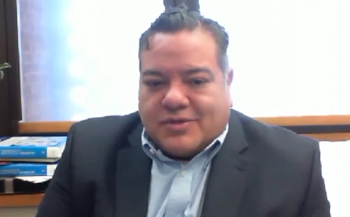
- July 2023
- Volume 38
- Issue 7
- Pages: 18–20
Differentiating Glycans by Surface-Enhanced Raman Spectroscopy
Glycoproteins are becoming popular in the pharmaceutical industry, prompting the need for an effective spectroscopic technique that can differentiate them. SERS is one such technique ideal for glycan analysis for several key reasons, which are discussed here.
There are many biological functions of glycans, spanning the spectrum from relatively subtle to absolutely crucial, pertaining to the development, growth, maintenance, or survival of the organism that synthesizes them, including (but not limited to) structural development, energy storage, and system regulation. Zac Schultz (ZS), a professor at the Ohio State University, and his graduate student Hannah Schorr (HS), are working on the use of surface-enhanced Raman spectroscopy (SERS) for the differentiation of glycans. Schultz and Schorr spoke to Spectroscopy about this work.
Why is identification and quantification of glycans on a protein important?
HS: Glycoproteins are becoming widely used in the pharmaceutical industry as both drug delivery targets and as therapeutic drugs themselves. In 2013, 11 of the top-20-grossing pharmaceuticals were glycoproteins. In 2021, the second-highest grossing pharmaceutical was a glycoprotein, second only to the COVID vaccine. Glycosylation, where enzymes attach sugars to specific protein residues, is the most common post-translational modification of proteins, and it can affect protein folding and function. Being able to rapidly identify and quantify which glycans are present can speed up the quality control system and ensure that the therapeutic drugs are being made properly. Understanding the glycome of a protein can also aid in figuring out where binding or other interactions with the protein are occurring, possibly opening new avenues for diagnostics and drug delivery systems.
ZS: Glycation, where sugars are reacting with free amines of proteins, is another area that appears to be important for understanding diseases such as diabetes. Being able to identify and quantify the sugar attached to proteins is difficult. In general, sugars play key roles in numerous biological functions, but the techniques to characterize them are rather limited, presenting an important research challenge.
Why was surface-enhanced Raman spectroscopy (SERS) chosen as the technique to detect and differentiate glycans and monosaccharides?
HS: Because glycans, and monosaccharides in particular, are often structural isomers, it can cause a real challenge in differentiation and detection. Many have the exact same mass, with the only difference being whether or not a hydroxyl is above or below the carbon ring. With SERS, we are able to probe the vibrations of the bonds in the molecule, and by using chemometrics, we are able to tell structural isomers apart, even when their spectra are quite similar.
ZS: A glib answer is because our lab does SERS. But in all seriousness, previous work in our lab suggested SERS could characterize sugars, and monosaccharides in particular. We saw previously that phosphorylated sugar isomers could be differentiated. Distinguishing metabolites was important, and applying SERS to characterize protein modifications was a logical next step.
What specifically makes SERS an analytical method of choice for glycan analysis in terms of sensitivity and selectivity to these analytes?
HS: SERS can be a useful tool for glycan analysis because of its insensitivity to water. Most of the time sugars are going to come from a biological sample, and the matrix is going to be an aqueous solution. The water insensitivity is also useful for liquid chromatography (LC) analysis due to the aqueous portion of the mobile phase. We don’t have to worry about any competing signals or figuring out how to ionize a sample. Since the goal is to analyze the whole glycome, we actually aren’t looking for a super selective technique. It’s good for us that we can detect all of the sugars and not just certain ones. With different surface monolayers, we can get detection down to near-physiological concentrations as well, which will be useful as we move forward with the project.
ZS: SERS provides information that can identify the glycan, which is an important part of the challenge. And, as Hannah noted, we have been able to adapt the methods we are developing into a technique that can address this previously unmet research need.
What is the optimum method of sampling for this analytical technique?
ZS: Ideally, you would like a sampling method that requires the least amount of sample manipulation. With SERS, you have to combine the sample with the SERS-active nanoparticles. Our sheath-flow SERS method enables liquid solutions to be directly analyzed without drying or mixing, both of which can result in misleading artifacts. This direct analysis of the solutions is really beneficial. Since the Schultz lab reported sheath-flow SERS almost 10 years ago, we have continued optimizing the sampling method, but it has been useful for the glycan analysis reported here and in other applications from our lab.
What was the most surprising result in your work? Were there any memorable limitations or challenges that you encountered?
HS: The most surprising result is definitely that we can use chemometrics to differentiate between the monosaccharides. Looking at the raw data, it all looks incredibly similar. It is challenging to pick out distinctions by eye. Principal component analysis (PCA) was able to take the small differences in relative peak heights between the sugar spectra and classify them into distinct clusters. It was really exciting to see that there was clustering based on structural similarities between the monosaccharides as well. The most challenging thing that we encountered doing this work is that sugars and SERS do not get along well. It’s very difficult to get a SERS spectrum of a bare monosaccharide, as the sugars seem to be repelled from the metallic substrates. Finding a way to encourage interaction between the analyte and the substrate was the biggest hurdle in this project, and luckily phenyl boronic acid (PBA) was the key to our success there.
ZS: I was surprised that the reaction with phenyl boronic acid improved the polarizability of the sugar as much as it did. This suggests other reactions may be appropriate for detecting other difficult analytes.
What feedback you have received from other researchers about this work?
HS: I had some positive feedback and interest while presenting at SciX 2022, especially regarding the in-flow portion of the research, but we’re still waiting for feedback on the published work. In the meantime, my mom thinks it’s pretty cool.
ZS: The work has been well received. Sugars are a challenging problem and people get excited if it looks like progress is being made. I have been given great suggestions for specific biological problems that would benefit from this analysis.
What discoveries do you hope to realize using this method of identification, and what do you think its impact will be in the future?
HS: My biggest hope is that we can actually implement this identification method when it comes to cleaving sugars off of a protein. The glycans on a protein are typically much more complex than monosaccharides, so we have quite a way to go before we can get this to a place where it would be applicable in a more commercial setting. If we can get there, this could be a big tool in pharmaceutical quality control, and it could also be used as a tool for general protein analysis.
What are the next steps in this research?
HS: There are a few different directions we’re heading next. The first is that we are working on figuring out a good method for separating mixtures of the PBA–sugar conjugates using liquid chromatography. The next is moving on to more complex sugars such as disaccharides and oligosaccharides. And finally looking at some glycosylated peptides to see if we can still pull out the signal from the present sugar. We have a lot of work ahead of us, but I’m excited to get into it!
ZS: Hannah has a good plan, and I am excited to see how far she can push this forward.
Articles in this issue
over 2 years ago
Preparation and Spectral Properties of MgAl2O4: Tb3+ Phosphorover 2 years ago
Infrared Spectroscopy of Polymers XIII: PolyurethanesNewsletter
Get essential updates on the latest spectroscopy technologies, regulatory standards, and best practices—subscribe today to Spectroscopy.




